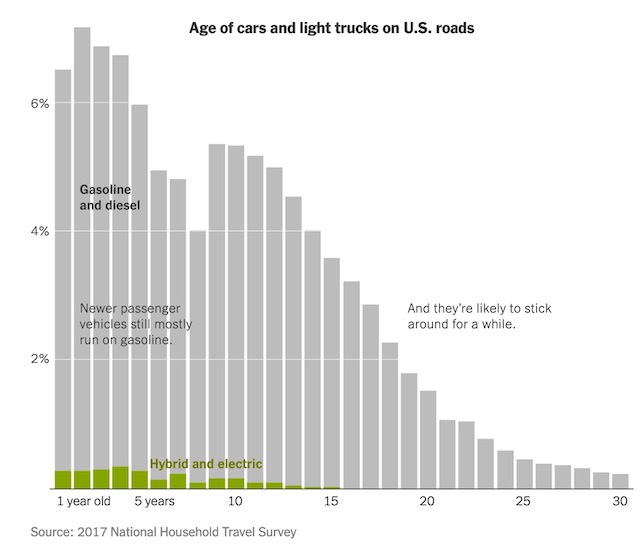Vehicle Fleet Turnover Is Very Slow, Unless More Aggressive Mandates Are Adopted
Basic Math Ignored
Intro Note:
The fake corporate funded EV cheerleaders won’t say anything about this corporate investment, which exposes the fact that absolutely nothing is changing under the “green” economy. Bloomberg reports:
The news reports and cheerleading of climate activists are not telling the full story on the challenges of electric vehicles (EV) as a technology to reduce greenhouse gas emissions.
And I don’t mean merely the totally unrealistic goals and timetables for EV sales and bans on sales of new gas/diesel vehicles; or the lack of charging infrastructure; opposition by car dealers; or lack of consumer confidence.
By failing to tell the full story, they propagate and allow false notions and unrealistic expectations to persist.
They fail to even talk about the other side of the electric vehicle fleet coin: the retirement of existing internal combustion vehicles ( we joked about that 15 years ago, see:
This neglect of the other side of the coin means that necessary more comprehensive and stronger policy tools are not even on the table.
One example: why not mandate at least a 1:1 buyback and retirement of an internal combustion vehicle for every EV sold, and do so as part of the EV sale?
That kind of mandate could also address the extremely regressive nature of the entire EV program and its subsidies, which benefit upper income drivers at the expense of lower income groups.
The fact of the matter is that, even if the unrealistic EV sales goals are met and sales of new internal combustion (gas and diesel fueled) vehicles are banned, that does not mean that that the vehicle fleet will even come close to being 100% electric. Similarly unrealistic expectations are stoked by false assumptions that there will be significant reductions in total vehicle GHG emissions.
That’s because the lifespan of an internal combustion vehicle is long (20-30 years) and increasing, so the fleet turnover is very slow.
Around the world, governments and automakers are focused on selling newer, cleaner electric vehicles as a key solution to climate change. Yet it could take years, if not decades, before the technology has a drastic effect on greenhouse gas emissions.
One reason for that? It will take a long time for all the existing gasoline-powered vehicles on the road to reach the end of their life spans.
This “fleet turnover” can be slow, analysts said, because conventional gasoline-powered cars and trucks are becoming more reliable, breaking down less often and lasting longer on the road. The average light-duty vehicle operating in the United States today is 12 years old, according to IHS Markit, an economic forecasting firm. That’s up from 9.6 years old in 2002.
Those facts mean that far more comprehensive and aggressive policies are required (unless the goal is just to pretend to reduce greenhouse gas emissions).
What kind of policies?
Why is the corporate mainstream NY Times outlining a more intelligent and aggressive policy agenda than the so called climate activists:
policymakers may need to consider additional strategies to clean up transportation, experts said. That could include policies to buy back and scrap older, less efficient cars already in use. It could also include strategies to reduce Americans’ dependence on car travel, such as expanding public transit or encouraging biking and walking, so that existing vehicles are driven less often.
“There’s an enormous amount of inertia in the system to overcome,” said Abdullah Alarfaj, a graduate student at Carnegie Mellon University who led a recent study that examined how slow vehicle turnover could be a barrier to quickly cutting emissions from passenger vehicles.
It is amazing that these “additional strategies” are presented as novel. The legal and policy framework to implement them has been in place for over 40 years.
Back in the day, environmentalists used to think more broadly and focus on the integration of land use, transportation, and clean air planning and regulatory strategies. (and I don’t mean merely seeking to stop diversions of Clean Energy Funds to NJ Transit!)
In fact, the Clean Air Act mandates exactly that and the NJ DEP is required to develop and enforce a State Implementation Plan (SIP) that has regulatory teeth to attain these integrated clean air and transportation goals.
But environmentalists, climate activists, and the media have largely abandoned work on those planning and regulatory programs – particularly land use – in favor of a narrow and blatantly commercial focus on the EV program.
It is likely that industry funding of the EV cheerleaders has had a huge impact on that narrowing focus (that means you, Doug O’Malley:
ChargEVC, made up of car manufacturers, technology companies, utilities, consumer advocates and non-government organizations, serves as the singular voice of a compelling message. …
The diversity of CHARGEVC is what makes the organization so valuable. Our members represent the key players that are crucial to shaping electric vehicle growth in a sound and sustainable manner. (my emphasis)
As a result, DEP is given a pass and gets completely captured by regulated industries and adoption and enforcement of SIP standards are neutered.
Like I’ve written many times, this another example of how we are actually going backwards on the policy frontier.

